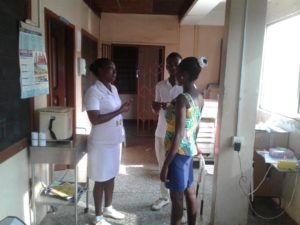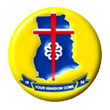The general ward is made up of female, male and pediatric wards.
FEMALE GENERAL WARD
The female unit at Ankaase consists of 16 beds with an approximate monthly caseload of 25-30 patients. The unit is dedicated to the care of female patients 16 years and above. The patients usually spend on average of one week at the unit.
There are 14 nurses (11 females, three males) of which four are Registered General Nurses, seven Enrolled Nurses, and three Ward Assistants. Nurses are responsible for the daily management of acute and chronic medical conditions such as malaria, hypertension, diabetes mellitus, HIV, gastrointestinal conditions among others. Patients are admitted to the unit directly from the outpatient department or the emergency department. The unit has accessories for oxygen therapy, suction and nebulizing of patients who may be in acute respiratory distress.
Patient centered care is the most important part of the practice model, thus, the right of the patient to participate in her care is observed and encouraged at all times.
MALE GENERAL WARD
The male medical ward is located adjacent to the children’s ward on the first floor of the hospital building and is managed by the same team of nurses as the pediatric ward. It’s made up of two wards, medical and emergency, with each ward containing four beds. Admissions, monitoring and oxygen therapy are done at the male emergency ward. Staff manage conditions such as malaria, hypertension, diabetes, cerebrovascular accidents, renal failure among others. Nurses activities include participation in vital sign assessment and recording, medication administration, health education, wound dressings and ward rounds with physicians and physician assistants.
PEDIATRIC WARD
The pediatric ward staff are responsible for the daily management of conditions affecting children, from birth to 18 years of age. It has been part of the hospital since its establishment and located on the top floor of the hospital building. The ward is made up of the emergency beds of which there are seven and medical beds of which there are eight.
Most of the admissions, monitoring and oxygen therapy are done at the emergency ward. Once the patient is stable, they are transferred to the medical ward. The pediatric ward is currently being managed by a pediatric In-Charge Nurse and supported by two Registered General Nurses, ten Enrolled Nurses and two ward assistants, making a total of 16 nurses.

Pediatric nurse-in-charge explaining plan of care to patient’s family.
The nurses care for children with various childhood illnesses, both medical and surgical. In addition, the nurses participate in ward rounds with physicians and physician assistants, perform wound dressings, health education to mothers and caretakers, administration of prescribed medications and documentation and implementation of discharge orders. Common managed conditions/diseases include malaria, anemia, pneumonia, sickle cell disease and gastrointestinal disorders.
Nurses are dedicated to the practice of family-centered care and do encourage parents and caretakers to become involved in the daily management of the children. This model of practice helps to decrease separation anxiety, alleviate fears and promote a caring and nurturing environment for both the parent/guardian and the child.
